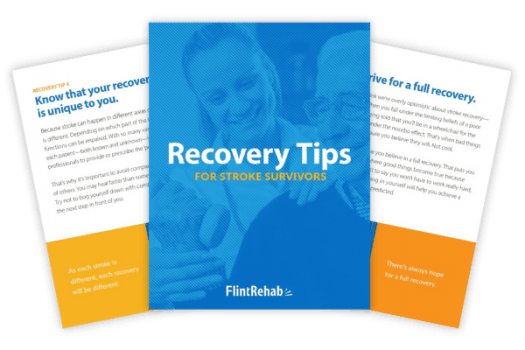MCA Stroke: Causes, Symptoms & Treatment for Stroke in the Middle Cerebral Artery
Middle cerebral artery stroke, called MCA stroke, is a neurological injury that can result in a variety of secondary effects, altering daily life for many survivors. Fortunately, there is hope for recovery through consistency, dedication, and commitment to an intentional rehabilitation program.
In this article we will discuss the causes of MCA stroke, common symptoms, and treatment to get you back to the activities you love.
What Causes MCA Stroke?
MCA stroke occurs when blood flow through the middle cerebral artery in the brain is interrupted. This can be due to ischemia, where blood flow is partially restricted, or infarct, where blood flow is restricted completely. Additionally, a stroke can be hemorrhagic, meaning the stroke was caused due to aneurysm or rupture of the artery. This leads to uncontrolled bleeding in the brain and can create an increase in pressure.
Most MCA stroke cases occur due to ischemia, which prevents the brain from getting sufficient oxygen and nutrients. This causes damage as brain cells begin to die and is why fast action is vital if someone begins to exhibit stroke symptoms. The faster medical care is administered, the more this damage can be contained and secondary effects can be minimized.
The middle cerebral artery branches off the carotid artery and is the most commonly-affected artery in acute stroke cases. Due to its importance for supplying blood flow to the brain, damage to the MCA can result in a wide variety of impairments. For example, the MCA supplies blood to major areas of the brain such as the primary motor cortex and somatosensory cortex, as well as deeper structures.
Furthermore, MCA stroke can be divided into two sub-categories, left and right. This refers to the side of the brain most affected by the loss of blood flow to the brain via the middle cerebral artery. Depending on which area of the MCA is specifically affected, either hemisphere can be damaged and lead to a wide variety of deficits.
Left MCA Stroke
The two hemispheres (halves) of the brain are each responsible for controlling the opposite side of the body. A left MCA stroke refers to a stroke that has resulted primarily in damage to the left hemisphere. This results in secondary effects present on the right side of the body, such as right hemiplegia (paralysis on the right side of the body) or right hemiparesis (weakness on the right side of the body). We will review other potential effects later in this article.
Right MCA Stroke
This type of stroke occurs following damage to the right distribution of the middle cerebral artery. The resulting damage to the brain’s right hemisphere causes deficits to be present primarily on the left side of the body, such as left hemiplegia or left hemiparesis.
Right MCA strokes occur less frequently than left MCA strokes but can be more difficult to recognize or differentiate due to unclear symptoms. Although right MCA strokes occur less frequently, this does not necessarily mean they are less severe.
Symptoms of MCA Stroke
Due to its extensive role in providing blood flow to the brain, damage to the middle cerebral artery can result in many different symptoms and secondary effects. This depends heavily on the area(s) of the brain affected as well as the severity of the stroke. To help you understand the differentiation of symptoms, we will discuss the different secondary effects of MCA stroke based on the hemispheres affected.
Common symptoms and secondary effects of left MCA stroke include:
- Motor Apraxia: Difficulty planning and carrying out movements
- Aphasia: Difficulty comprehending language, forming words, or building complex sentences
- Numbness or weakness on the right side of the body
- Increased frustration
- Impaired swallowing ability
- Cautious behavior
- Memory impairment
Common symptoms and secondary effects of right MCA stroke include:
- Left side paralysis
- Facial weakness
- Reckless behavior or poor decision making
- Left neglect
- Visuospatial deficits
- Memory impairment
Although MCA strokes are sometimes divided into left and right, this classification is not always clear in every stroke case. Some individuals experience damage to both hemispheres following MCA ischemia, leading to a combination of symptoms.
Diagnosis and Initial Treatment
When an individual reaches the hospital with suspected stroke symptoms, the initial focus of treatment is containing the stroke and minimizing damage to the brain. To help resolve ischemia, the individual may be given a medication called tissue plasminogen activator, or tPA. TPA is primarily used to break up a clot and help restore blood flow to the brain, although it must be administered within 3-4.5 hours after symptom onset.
Diagnosis of an MCA stroke generally occurs using imaging such as CT or MRI to help pinpoint the area of the brain affected. Imaging is commonly performed within the first hour after an individual is admitted to the hospital as this allows medical staff to appropriately provide the necessary treatments.
Although some strokes can be managed with medication, some require surgical intervention to remove a clot or decrease pressure on the brain. This depends on the type and severity of the stroke and can include procedures such as a mechanical embolectomy (sometimes called a thrombectomy) or a craniotomy.
Rehabilitation for Stroke in the Middle Cerebral Artery
The secondary effects of MCA stroke vary widely depending on the areas of the brain affected. These secondary effects can include motor, somatosensory, cognitive, and emotional impairments. However, there is always hope for survivors of MCA stroke to regain function and improve quality of life through a comprehensive rehabilitation program.
After injury to the brain, the nervous system can heal and restore function through a process called neuroplasticity. Utilizing neuroplasticity, areas of the brain that did not sustain damage are able to create new connections and neural pathways, compensating for a loss in function after MCA stroke.
Following MCA stroke, rehabilitation can consist of many treatments and therapies to help regain lost function. This can include physical, occupational, speech, and cognitive therapy to help address and improve all aspects of daily life. Following MCA stroke, the main goals of rehabilitation will include:
- Restoring physical function
- Maximizing independence and activities of daily living (ADLs)
- Enhancing cognitive and emotional function
Restoring Physical Function
One major goal for survivors of MCA stroke is regaining lost physical function. This will be the focus of physical and occupational therapy to enhance performance of daily activities. In addition to in-person sessions, your therapy team will provide you with exercises for you to perform on your own to help you maximize your recovery.
A physical therapist will help you practice exercises focusing on range of motion, muscle strength, transfers (moving from one surface to another), and walking. An occupational therapist can help you relearn necessary activities of daily living, such as grooming or dressing, as well as work on gaining function of the hand and arm.
Maximizing Independence
Following MCA stroke, many survivors may feel they have lost some of their independence. Fortunately, physical, occupational, and speech therapists are trained to help you regain your independence with physical functions and motor skills.
For example, occupational therapists can recommend appropriate adaptive equipment to help you be as safe and independent as possible in your home environment. Speech therapists will help you work on swallow and speech skills to allow you to eat safely and communicate with others, increasing your freedom at home and in the community.
Lastly, physical therapists can help you move independently by working with you to increase your balance and overall mobility. In addition to walking, they can help you improve your ability to get in and out of bed, stand up from a chair, and help you create a plan to get regular exercise after MCA stroke.
Enhancing Cognitive Processing & Emotional Regulation
In addition to physical deficits, MCA stroke can lead to changes in emotional regulation and decreased cognitive function. As part of your rehabilitation plan, occupational and speech therapists can help you work on drills and exercises to allow you to develop critical-thinking skills and enhance cognitive processing. This may include cognitive exercises such as brain teasers, word games, and multi-tasking activities performed alongside a physical exercise.
Many survivors also experience behavioral and emotional changes after MCA stroke. This is where a cognitive-behavioral therapist can be of assistance. These are trained health experts who can help you pinpoint negative behaviors or thought patterns and develop strategies to overcome them. They can also help you learn new strategies to cope with life changes and work through feelings of grief or sadness that you may experience after MCA stroke.
Depression is a commonly experienced condition following stroke, affecting as many as 1/3 of stroke survivors. It is important to talk with your provider if you are experiencing symptoms of depression to develop a treatment plan and get connected with helpful resources.
Summary
MCA stroke can affect either hemisphere of the brain, resulting in a wide variety of symptoms depending on the areas affected. Left MCA stroke affects the left hemisphere of the brain and causes deficits on the right side of the body. Contrarily, right MCA stroke affects the right side of the brain and often results in left-sided paralysis or neglect, impulsive behavior, and facial weakness.
Identifying the areas of the brain affected and resulting deficits can allow your rehab team to create a comprehensive plan to help you reach your goals and regain independence.
We hope this article has helped you better understand the symptoms of MCA stroke as well as encourage you to pursue rehabilitation. All stroke survivors can achieve improvement in function through neuroplasticity and consistent, dedicated practice.

Each half of the occipital lobe processes visual information from the opposite side of the visual field. Therefore, the right occipital lobe is responsible for processing input from the left visual field, and vice versa. When a stroke affects the occipital lobe only on one side, it can cause blindness on the opposite side of the visual field. For example, a stroke in the left occipital lobe can result in blindness on the right side of the visual field.
Similarly, a stroke in the right occipital lobe can result in blindness on the left side of the visual field, also known as a left visual field cut. This is different from left neglect after stroke, which is an attention problem while hemianopia is a visual problem.
Someone with left neglect may not notice you when approached from the left side because they do not have the cognitive awareness to notice their surroundings on the left half of their body. Someone with a left visual field cut may not notice you when approached from the left because their brain is not processing visual information from that side.
Central vision loss

Hemianopia occurs because each half of the occipital lobe processes visual information for the opposite side of the visual field. However, it’s also possible for an occipital lobe stroke to cause a loss of vision in the center of your visual field, a condition known as central vision loss.
Cortical blindness
When all vision is lost after an occipital lobe stroke, it’s called cortical blindness. This differs from “regular” blindness because the eyes are unaffected, but the visual processing abilities of the brain have been severely compromised.
Visual hallucinations
In rare cases, an occipital lobe stroke can result in vivid hallucinations where survivors see various images like lights, sparks, colorful pinwheels, etc. When visual hallucinations occur while other cognitive functions are preserved, it’s called Charles Bonnet Syndrome.
Prosopagnosia
Prosopagnosia refers to “face blindness” where survivors cannot recognize faces. This may occur when the area responsible for facial recognition, the fusiform gyrus (where the temporal and occipital lobes meet), has been impacted by stroke.
For loved ones, it can be alarming when a survivor does not recognize family members. However, many survivors with prosopagnosia can still recognize voices, so try your best to be patient and understanding and use your voice to remind your loved one of who you are.
Visual agnosia
Visual agnosia occurs when a survivor cannot identify familiar objects and/or people by sight. This is a subtype of agnosia, a condition that affects the brain’s ability to process what you see, hear, or touch. With visual agnosia, only the ability to process what you see is affected. This can occur after an occipital lobe stroke because this structure of the brain specifically processes vision.
Alexia without agraphia
A stroke in the occipital lobe can also cause a condition known as alexia, without a common accompanying condition known as agraphia. Alexia refers to an inability to read or understand written words. Agraphia refers to an inability to communicate through writing.
When an occipital lobe stroke causes alexia without agraphia, it means the survivor cannot read or understand written words but they can still communicate through writing. This is because alexia without agraphia is a visual problem, not a language problem. Reading involves processing visual input while writing involves cognitive language and fine motor skills.
When a stroke only affects the occipital lobe, studies have reported that survivors often have “no significant neurological deficits other than visual-field loss.” If you or someone you know has sustained more than just vision challenges after an occipital lobe stroke, it’s possible that the stroke affected nearby structures in the brain such as the cerebellum, brain stem, temporal lobe, and/or thalamus.
Rehabilitation for Occipital Lobe Stroke
With most secondary effects of an occipital lobe stroke involving vision problems, rehabilitation will revolve around restoring your sight and finding compensatory strategies to make up for visual losses.
Talk to your doctor, who can refer you to a neuro-ophthalmologist or neuro-optometrist. It’s important to see specialists who understand the neurological impact of the stroke on visual processing. A regular optometrist may not be able to help.
After seeing a specialist, some treatment plans may include vision restoration therapy. This rehabilitation method capitalizes on neuroplasticity after stroke, which involves the brain’s ability to heal itself and form new neural networks.
To activate neuroplasticity, vision restoration therapy involves rigorously practicing vision training exercises. Some modalities used include eye movement training (eye exercises), hand-eye coordination exercises, or light therapy. Although research was once very limited, new studies show that intensive visual training may help improve hemianopia (visual field cuts) after an occipital lobe stroke.
Some occupational therapists also receive specialized training to assist individuals with visual challenges. They may be able to educate you in low vision safety strategies, such as placing brightly colored tape on the edge of stairs.
Vision is important for carrying out the activities of daily living, so it’s important to exercise caution and work with trained specialists when your vision has been affected by a stroke.
Outlook for Occipital Lobe Stroke
Depending on their circumstances, some occipital lobe stroke survivors choose to just live with their visual challenges. However, many others have a great desire for improvement. Survivors may wonder if recovery is possible, especially if a significant amount of time has passed since their stroke.
The brain generally heals the most rapidly during the first 3 months after stroke, and rehabilitation during this time often produces faster results than the months or years thereafter. This is also the timeframe where spontaneous recovery is more likely. Spontaneous recovery happens when the brain repairs and salvages the penumbra (the brain tissue surrounding the affected area of the brain) and some functions, such as vision, improve without any intervention. The first three months, therefore, are an excellent time to pursue recovery for any stroke, including occipital lobe strokes.
If a survivor is past the first few months of recovery, they may lose hope for restoring vision after an occipital lobe stroke. Fortunately, the brain is capable of rewiring itself throughout a person’s entire life. Even if it has been many months or years since the event of a stroke, survivors are still encouraged to pursue rehabilitation to maximize their chances of rewiring the brain and improving function.
Every stroke is different and therefore every recovery is different. Some occipital lobe stroke survivors will naturally regain their vision through spontaneous recovery, while others may need to be more intentional about pursuing recovery. Although not everyone regains their vision, there is always hope for recovery through vision restoration therapy at any point.
Understanding Occipital Lobe Stroke Recovery
Overall, there is hope for recovery from occipital lobe stroke. By working closely with your medical team, you can come up with a rehabilitation plan that will help you navigate your new life after stroke.
Not all survivors will benefit from vision restoration therapy, but many will, and it’s important not to give up hope even if you think too much time has passed. Also, be sure to work with an occupational therapist or other specialist to learn how to adapt to any visual changes to ensure your safety throughout the day.
We hope this article helped you understand the effects and recovery process for occipital lobe strokes. For more information, see our comprehensive article on the areas of the brain affected by stroke.
Keep It Going: Download Our Stroke Recovery Ebook for Free

Get our free stroke recovery ebook by signing up below! It contains 15 tips every stroke survivor and caregiver must know. You’ll also receive our weekly Monday newsletter that contains 5 articles on stroke recovery. We will never sell your email address, and we never spam. That we promise.
